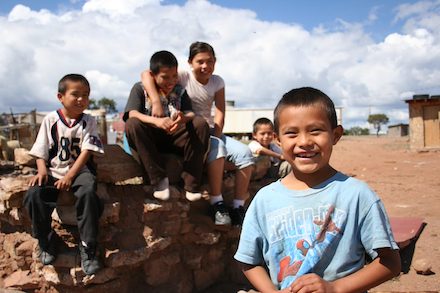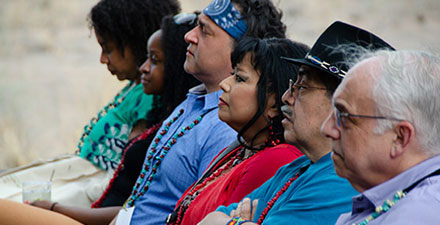Supporting Native communities is about listening and relationships

The Northwest Area Foundation has been a longtime funder of Native communities. But it wasn’t until we showed up as listeners and learners, and not as experts, that our effectiveness truly blossomed. The transformation is summed up well by an Alan Alda quote: “Unless I’m willing to be changed by you, I’m not really listening.”
We’ve come to understand that Native communities need to determine their own futures, not funders. That means we stop trying to lead and, instead, stand with them as leaders of the change needed to thrive on their own terms.
Our 40% commitment to Native-led groups: Listening, learning, and growing
Many years ago, a series of frank conversations with Native communities revealed we needed to show up as allies with a deeper commitment to their work. We listened, and we responded in 2012 with a commitment to place 40% of our grant dollars each year with Native-led groups, meaning that a majority of their staff and board members are Native Americans.
The commitment is an intentional public pledge to stand alongside Native communities. It’s an expression of solidarity with groups led by and for Native communities. Since 2012, we’ve made more than $87 million in grants to Native-led groups—more than 45%of total grant dollars. This is nearly 200 times the rate of funders nationally, which stands at a mere 0.23%.
13 years of living into the commitment: How we’ve grown as funders
Here are our takeaways:
1. Build the relationship. First and foremost, good grantmaking is about good relationships. Show up and, before you speak, listen in a respectful way to communities who are too often overlooked and ignored.
This could mean visiting a reservation community or Native neighborhood in your city and taking time to listen to leaders and community members. Go to a tribal council meeting or the offices of a Native-led nonprofit and simply introduce yourself. Or you could attend a convening or a conference hosted by Native Americans in Philanthropy. But take the first step now. It’s the relationship that matters most to Native communities.
2. Native communities view prosperity differently. Spending time to understand Native communities’ worldviews has helped us honor their expertise, values, and lived experience. Seen through a Western lens, Native communities might appear impoverished. But Native communities find prosperity in many forms, which include strong connections to ancestral wisdom, their relationship to the land, the practice of traditions that span generations.
3. See like an eagle, not like a mouse. More than a decade ago, our foundation’s staff attended a convening with grantee partners from the Cheyenne River Sioux Tribe, Turtle Mountain Band of Chippewa, and the Lummi Nation. One of the grantees told us: “See like an eagle, not like a mouse.”
In other words, Native communities tend to view life through the wide and long lens of generational change, looking beyond deficits and barriers to see what we can do in the present that can lead to prosperity for seven generations into the future.
4. Native people want to thrive on their own terms. We see amazing work across Indian Country as Native people break away from the harm of longstanding disparities rooted in discrimination, exclusion, and violence and, along with this, promote healing and change. This work includes Tribal and youth-led groups that tap millennia-old practices of healing and restoration, as well as coalitions of vibrant leaders creating access to financial services that better meets the cultural interests of Native communities. Our approach needs to follow alongside these communities on paths they’ve chosen for themselves.
“Self-determination” is the term many Native grantees use to express this idea. It refers both to the need to recognize the sovereignty of tribes as nations and the ability of community members to make and enact decisions about their lives so they can achieve prosperity as they define it.
2025 and beyond: Continuing to learn and raise awareness
Listening and learning is a practice we engage in that allows us to use each new round of grantmaking as a way to evolve alongside our grantees. In late 2021, for instance, in response to mutual learning from Native grantees and others, we changed our grantmaking approach to support work that restructures unjust systems. In 2023, we followed suit by changing our mission to focus on justice.
Importantly, we’re looking to partner with other funders by raising awareness and increasing capacity to fund Native organizations. To do this, we’ve developed our own content, appeared at conferences, and spread the word on other platforms, like this one. And, of course, we’re continuing to show up and listen so we can grow alongside our Native partners.
Photo credit: Standing Rock Community Development Company







